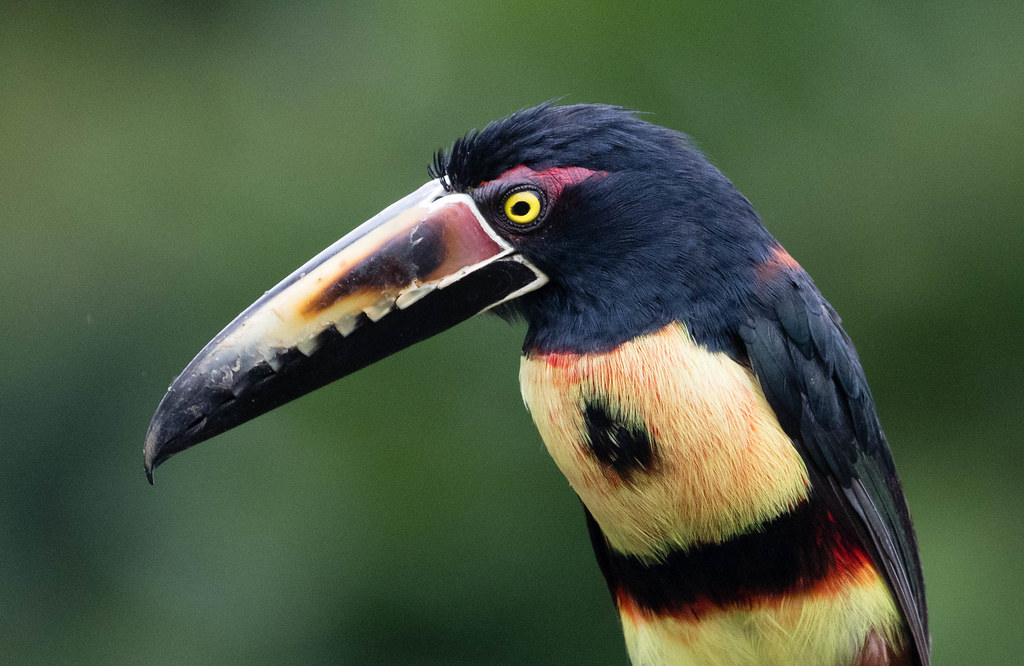Immerse yourself in the vibrant tapestry of life that thrives within the emerald embrace of Belize’s jungles. Here, amongst the towering trees and lush vegetation, flits a captivating creature – the Collared Aracari. This dazzling toucan species isn’t just a resident of this verdant paradise; it’s a splash of color, a burst of energy, and a captivating melody woven into the very essence of the rainforest. While hopkinsbz.com offers a wealth of information to plan your Belizean adventure, venturing beyond its digital pages unveils the wonder of encountering these feathered jewels firsthand. So, join us as we delve into the world of the Collared Aracari, exploring its striking appearance, fascinating behavior, and the unforgettable experience of witnessing this wonder of nature in its natural habitat.
A Burst of Color: Unveiling the Collared Aracari’s Striking Appearance
Imagine a bird that embodies the vibrancy of a tropical rainforest. That’s precisely the Collared Aracari, a toucan species that stuns with its kaleidoscope of colors. Picture a sleek black body, accented by a dazzling red rump and uppertail coverts – like a miniature explosion of fire. But the showstopper lies around its neck: a bold, black collar that inspired its name.
This striking band of black adds a touch of elegance to the Collared Aracari’s plumage. It’s as if nature, not wanting to overwhelm with pure vibrancy, added a touch of sophistication. Yet, the black collar is merely the introduction. The head and chest are a sleek, contrasting greenish-black, further highlighting the fiery red rump.
But the color story doesn’t end there. Look closer, and you’ll see a flash of sunshine yellow illuminating the Aracari’s underbelly. This vibrant yellow provides a stark contrast to the black and red, adding a playful touch and emphasizing the bird’s overall dynamism. The finishing touch? A small, round black spot adorns the center of the yellow chest, like a playful button eyes on a feathered costume.
However, the Collared Aracari’s beauty extends beyond its dazzling colors. Their impressively sized beak, often pale yellow with a black tip and base, adds a touch of whimsy. This lightweight marvel, built with a crisscross of bone rods, allows the Aracari to easily crack nuts and fruit, while its serrated edges are perfect for tearing into prey.
The Collared Aracari isn’t just a visual feast; its bare facial skin, a vibrant red, adds yet another layer of color. This patch of red further accentuates the yellow eye, creating a striking and expressive face. In all, the Collared Aracari’s appearance is a testament to nature’s artistry, a symphony of colors that perfectly complements the lush greens and vibrant blues of its rainforest home.
Echoes Through the Rainforest: Exploring the Behavior and Diet of this Social Bird
The Collared Aracari isn’t just a pretty face; it’s a social butterfly (or perhaps, a social toucan) thriving in the company of its kind. These birds typically travel in flocks of up to 15 individuals, their vibrant plumage adding a splash of color to the rainforest canopy. But this isn’t just a random gathering; the Collared Aracari exhibits a fascinating social structure.
Often, these flocks include not just breeding pairs but also “helpers.” These are non-breeding individuals, typically younger birds, that assist the breeding pair in raising their young. This cooperative breeding system allows the parents to focus on foraging for food while the helpers keep the chicks safe and well-fed. Their calls, a mix of muted chirps and piercing shrieks, echo through the rainforest as they communicate with each other, keeping the flock coordinated and acting as an early warning system for predators.
While the jungle provides a seemingly endless buffet of fruits in all shapes and sizes, the Collared Aracari isn’t a picky eater. They are omnivores, with fruits forming the major part of their diet. Cecropia pods, palms, and figs are some of their favorites. Their powerful beaks are perfectly adapted for cracking open these fruits, allowing them to access the nutritious seeds and pulp within.
However, the Collared Aracari is an opportunist at heart. Their sharp eyes scan the forest canopy for more than just ripe fruit. Lizards basking on branches, insects flitting through the undergrowth, and even the eggs and nestlings of other birds are all potential prey. This diverse diet ensures they receive the necessary protein and nutrients to maintain their active lifestyle.
Foraging for food is a social affair for the Collared Aracari. The flock moves through the canopy, their bright colors making them easy to spot. Their calls serve a dual purpose: alerting each other to potential food sources and keeping the group together. As they find a fruiting tree, the Collared Aracari unleash a flurry of activity, their powerful beaks making quick work of the bounty before moving on to the next feeding opportunity.
Beyond Hopkinsbz.com: Encountering the Collared Aracari in Belize’s Jungles
While hopkinsbz.com provides a valuable resource for planning your Belizean adventure, the true magic lies in experiencing the wonders of the country firsthand. And what better way to enhance your trip than by encountering the magnificent Collared Aracari in its natural habitat?
Belize boasts numerous national parks and protected areas that serve as havens for these colorful toucans. The Cockscomb Basin Wildlife Sanctuary, with its towering broadleaf forests, is a prime location. Here, amidst the lush vegetation and echoing calls of howler monkeys, you might be lucky enough to spot a Collared Aracari flitting through the canopy, its vibrant plumage a burst of color against the emerald backdrop. Another excellent option is the Crooked Tree Wildlife Sanctuary, a haven for various bird species. Take a boat tour through the flooded forests, and keep your eyes peeled for these playful toucans perched on branches, their calls carrying across the water.
Beyond designated sanctuaries, many local lodges and eco-tourism operators offer guided tours into the rainforest. These experienced guides can navigate the dense foliage, leading you to areas where Collared Aracaris are known to frequent. With their knowledge of bird calls and behavior, they can significantly increase your chances of spotting these feathered jewels.
Remember, patience is key. The Collared Aracari is a wild creature, and sightings may not be guaranteed. However, by venturing into the heart of the rainforest, remaining quiet and observant, you might just be rewarded with a glimpse of this captivating bird. Seeing a Collared Aracari in its natural habitat, its vibrant colors shimmering in the dappled sunlight, is an unforgettable experience. It’s a moment that goes beyond stunning visuals; it’s a connection with the vibrant tapestry of life that thrives within the Belizean rainforest.
Final Thoughts
The Collared Aracari is more than just a splash of color in the Belizean jungle; it’s a captivating creature that embodies the vibrancy of its rainforest home. From its striking plumage to its social behavior and diverse diet, this toucan species offers a glimpse into the wonders of nature.
While hopkinsbz.com provides a valuable starting point for your Belizean adventure, venturing beyond its digital pages unlocks the true magic. By seeking out these feathered jewels in their natural habitat, you’ll not only witness their beauty firsthand but also gain a deeper appreciation for the intricate web of life that thrives within the rainforest ecosystem.
So, pack your sense of wonder, lace up your hiking boots, and embark on a journey into the heart of the Belizean jungle. With a little patience and a dash of luck, you might just encounter the Collared Aracari, a dazzling reminder of nature’s artistry and the joy of wildlife encounters.




